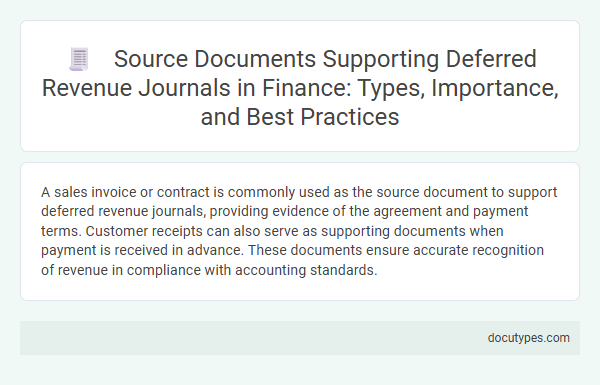A sales invoice or contract is commonly used as the source document to support deferred revenue journals, providing evidence of the agreement and payment terms. Customer receipts can also serve as supporting documents when payment is received in advance. These documents ensure accurate recognition of revenue in compliance with accounting standards.
Introduction to Source Documents in Deferred Revenue
Source documents are essential for recording deferred revenue accurately in financial statements. Common types include customer contracts, advance payment receipts, and subscription agreements, which provide proof of payment before service delivery. Understanding these documents helps you verify the timing and amount of revenue to be recognized later.
Key Types of Source Documents for Deferred Revenue
Deferred revenue journals require accurate source documents to validate the recognition of unearned income. These documents provide essential evidence for recording liabilities before revenue is earned.
- Customer Invoices - Invoices issued for advance payments indicate amounts received but not yet earned, supporting deferred revenue entries.
- Contracts and Agreements - Sales contracts outline terms and conditions that specify when revenue should be recognized, serving as legal backing for deferrals.
- Payment Receipts - Receipts confirm cash collections received in advance, ensuring accurate matching of income to future periods.
Using these source documents ensures compliance with accounting standards and improves financial statement reliability.
Role of Contracts and Agreements in Deferred Revenue Recognition
Deferred revenue journals are primarily supported by contracts and agreements that outline the terms of payment and delivery of services or goods. These legal documents serve as crucial evidence for recognizing deferred revenue in financial records according to accounting standards.
- Contracts define payment obligations - They specify when payments are received in advance and under what conditions revenue can be recognized over time or upon delivery.
- Agreements determine performance obligations - They identify specific services or goods to be provided, guiding the timing and amount of revenue recognition.
- Source documents ensure compliance - Contracts and agreements provide verifiable proof that supports accurate journal entries for deferred revenue in accordance with GAAP or IFRS.
Importance of Invoices and Billing Statements
Invoices and billing statements serve as primary source documents to support deferred revenue journals by providing detailed records of payments received in advance for goods or services yet to be delivered. These documents establish clear evidence of the transaction date, amount received, and terms agreed upon, ensuring accurate revenue recognition according to accounting standards. Proper documentation through invoices and billing statements enhances financial transparency and audit compliance while maintaining accurate deferred revenue balances on the balance sheet.
Supporting Documentation for Upfront Payments
What type of source document is used to support deferred revenue journals for upfront payments? Source documents such as customer contracts and payment receipts are essential for validating deferred revenue entries. These documents provide detailed evidence of the payment terms and the timing of revenue recognition.
Audit Trails: Receipts and Proof of Payment
Source documents used to support deferred revenue journals are essential for maintaining accurate audit trails. These documents provide proof of advance payments and validate the recognition of deferred revenue in financial statements.
- Receipts - Receipts serve as official records confirming customer payment in advance of revenue recognition.
- Proof of Payment - Bank statements and payment confirmations establish the authenticity of the received funds.
- Contracts or Agreements - These documents outline the terms of service or delivery, supporting the timing of revenue recognition in line with accounting standards.
Best Practices for Maintaining Deferred Revenue Documentation
Source documents supporting deferred revenue journals typically include customer contracts, advance payment receipts, and subscription agreements. These documents provide evidence of payment received before service delivery, ensuring accurate revenue recognition.
Best practices for maintaining deferred revenue documentation involve systematically organizing all source documents in a secure digital or physical repository. It is essential to regularly reconcile deferred revenue balances with supporting documents to identify discrepancies early. Clear documentation supports audit trails and compliance with accounting standards such as ASC 606 and IFRS 15.
Challenges in Document Management for Deferred Revenue
| Source Document Type | Customer contracts, sales invoices, and advance payment receipts |
|---|---|
| Role in Deferred Revenue Journals | These documents provide evidence of payments received before service or product delivery, supporting accurate recognition of deferred revenue in accounting records. |
| Common Document Management Challenges |
|
| Impact on Deferred Revenue Accuracy | Improper or delayed document handling can cause misstated deferred revenue balances, financial reporting errors, and regulatory compliance risks. |
Compliance and Regulatory Requirements for Source Documents
Source documents used to support deferred revenue journals typically include customer contracts, advance payment receipts, and subscription agreements. These documents provide verifiable evidence of payment received before the delivery of goods or services, ensuring accurate revenue recognition.
Compliance with accounting standards such as GAAP or IFRS mandates maintaining these source documents to validate deferred revenue entries. Your adherence to regulatory requirements ensures audit readiness and financial statement accuracy.
What Type of Source Document Is Used to Support Deferred Revenue Journals? Infographic

